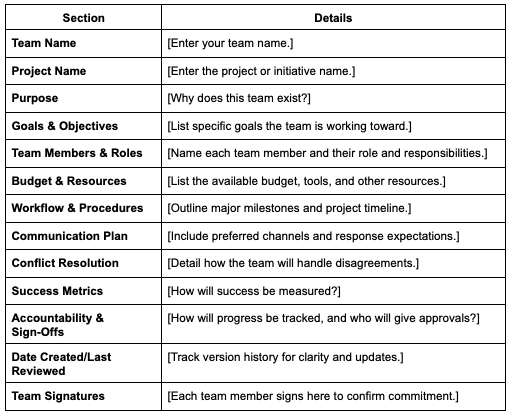Level up Your Management Style With a Team Charter

Table of contents
The Path to Becoming an Athena Assistant
Only the top 1% of applicants make it to the Athena Bootcamp – an acceptance rate more exclusive than Harvard University.
If a team shares the same goals but not the same playbook, it can lead to misunderstandings, mixed priorities, and missed deadlines. That’s where a team charter comes in. It’s a simple, strategic document that aligns expectations and lays out how the group will work together. With a clear charter in place, teams build trust faster and navigate challenges with confidence.
Keep reading to learn what a team charter contains and a step-by-step guide to creating one. We’ve also included a team charter template to help you get started.
What’s a Team Charter?
A team charter is a shared document that defines collective goals, individual roles, and guidelines for collaboration. Usually created by a manager or team lead, it defines what the group wants to accomplish and the standards everyone agrees to uphold.
Charters ensure everyone is on the same page from the outset, reducing confusion and improving accountability. With clarity around roles and responsibilities, teams are more focused and deliver better results.
When Leaders Should Develop a Team Charter
Here are some instances when a team charter can strengthen collaboration:
- Launching a new team: This document defines how the team will operate and creates a sense of direction.
- Starting a major project: A charter equips cross-functional teams with shared objectives and expectations from the start.
- Changing roles or leadership: New members and leadership changes can disrupt team dynamics, but revisiting the charter keeps everyone aligned on hierarchy, responsibilities, and goals.
- Combatting performance issues: If the team is missing deadlines or struggling with communication, a charter can help foster accountability and clarify expectations.
- Working remotely: A charter can establish norms for communication and collaboration to keep distributed teams in sync.
For support on your team charter, consider hiring an Athena Assistant. They help facilitate the process, establish goals, and manage communication.
Advantages of a Team Charter
A well-crafted team charter lays the foundation for strong performance, offering clarity and structure. Here are the key benefits of using one:
- Creates transparent workflows: A team charter specifies how work gets done and by whom. This transparency builds trust and encourages open communication.
- Clarifies roles and responsibilities: Charters define who’s responsible for what so team members don’t overlap their efforts. This streamlines collaboration and emphasizes individual accountability.
- Highlights sources of support: A charter identifies available resources and key points of contact. This makes it easier for people to get help as needed.
- Increases project success: Having clear goals and expectations helps teams stay focused and increase efficiency throughout the project.
Essential Elements of a Team Charter
A strong team charter includes several fundamental elements that align everyone around shared goals and expectations. Here’s what to cover in yours:
- Purpose and goals: Define the team’s purpose and what you’re working to accomplish, including short-term goals and long-term vision.
- Roles and duties: Specify each member’s role and responsibilities to prevent any gaps or overlaps. Without this clarity, people may duplicate work or assume others are handling critical tasks, which can slow progress.
- Financials and resource allocation: Detail available resources, including the budget and materials, and explain how the team will allocate them.
- Workflow and procedures: Determine how the team will manage work day-to-day, including the specific processes, tools, and timelines for getting things done.
- Communication guidelines: Set expectations for how people will communicate, including meeting frequency, preferred channels, and response times.
- Collaboration rules and conflict management: Agree on how the team will make decisions and handle workplace conflicts or challenges.
- Performance metrics and evaluation: Brainstorm how the group will measure progress and what success looks like.
- Ownership and approvals: Decide how to hold team members accountable for their contributions, such as review checkpoints or final approvals.
7 Easy Steps to Create a Team Charter
Writing a project management charter is one of the most effective ways to set expectations, and it’s not complicated to do. Follow these simple steps to create one.
1. Define the Team’s Purpose
Kick things off by outlining why the team exists and what you want to achieve. This mission statement keeps the group unified around a shared vision. Get specific about the project scope and the results you’re striving for.
2. Describe the Team’s Structure
Detail who’s involved and the unique part each person plays. A clear structure is essential for smooth collaboration and helps new team members quickly find their place and contribute confidently. When you define roles and responsibilities upfront, team members gain a sense of ownership.
3. Plan Resource Allocation
Take stock of what you have — money, tools, and talent — and map out how you’ll apply each to support your work. Thoughtful planning prevents surprises and keeps projects on track, so revisit your resource allocation to adjust for any changes.
5. Detail Workflows
Lay out the steps, processes, and timelines your team will follow. In addition, decide which tools and time management techniques you’ll use to boost productivity. Documented workflows and procedures can also help new team members onboard quickly.
6. Set Standard Communication Methods
Outline how and when your team will communicate. Include details such as meeting schedules and scope, go-to channels, and expected response times. Setting these communication norms in advance keeps information flowing and avoids misunderstandings or delays. Make regular check-ins and quick updates a habit to maintain alignment.
7. Create Rules for Conflict Resolution
Set ground rules for tackling conflicts quickly, focusing on finding solutions rather than assigning blame. Having a plan for addressing challenges creates a safe space where trust and openness thrive.
8. Review the Charter and Obtain Approvals
Share your charter with team members for feedback. Make necessary adjustments and ensure everyone understands and agrees with the contents. Then, collect signatures from the team to make the charter official and reinforce accountability. Keep the final version easily accessible so people can use it as a reference point.
Team Charter Example and Template
If you need inspiration, this charter example and template will help you build an effective team document tailored to your goals.
Team Charter Template

Team Charter Example

Get Started with an Athena Assistant
A team charter sets expectations, but day-to-day execution keeps your team moving forward. An Athena Assistant can help bring your charter to life and uphold its standards.
From documenting workflows to coordinating projects, your assistant will handle time-consuming tasks. Each Athena Assistant is trained rigorously and backed by expert coaches to help your team reach its full potential. Get started with an Athena Assistant today.



















